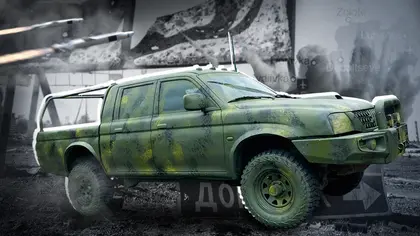From the first day of Russia’s invasion, ordinary Ukrainians have rallied around their military and helped where they could. This included making donations to provide humanitarian aid, medical equipment and for the purchase of military items such as drones, thermal imagers, sights and the like. Vehicles – from pick-ups to quad bikes to sedans – have also been key items for voluntary efforts.
JOIN US ON TELEGRAM
Follow our coverage of the war on the @Kyivpost_official.
However, ‘donor fatigue’ can set in as war drags on. Then, risk arises as battle equipment gets lost, damaged, or just wears out very quickly. Just as war continues, so continues the need for volunteers and civilians providing re-supply, it seems.
This is especially true for both military and civilian vehicles used in appalling frontline conditions. In the best case, even if a vehicle is not fired upon, it is estimated that it ‘lives’ at the front for a maximum of two to three months.
"A few months ago, I fully repaired a military car and a week later it was back again,” Mykola Svistukhin, a military commander told Kyiv Post during a visit to frontline areas. “These cars are used in brutal conditions. Imagine that if even iron can't stand it, what is it doing to our people?"
For unarmored civilian cars, the situation is the worst. Many will last in the war zone for about a month, if lucky. There is no chance to save a ‘metal horse’ if it is hit with machine guns, mortars or artillery or if it runs over a mine. There is also the probability that cars will have serious traffic accidents as tired, stressed soldiers driving on bad roads make mistakes.

Trump Comments Calling for Kremlin Concessions Ignites Firestorm of Russian Objections
"We even have cars that don’t survive a day in the war zone. We once raised funds for a passenger car, repaired it, repainted it, and sent it to the front. The military parked it up next to two others when an artillery shell landed and destroyed all three cars at once. It had literally been at the front for an hour," Svistukhin recalled.
However, even in their short ‘lives’, these vehicles perform an important role. They allow troops with all their weapons and equipment to move rapidly to positions where they are needed.
"If there is no car, then soldiers are forced to wait for trucks, which may not be readily available. If the military team has its own vehicle, they can get into it at a moment’s notice and deploy with everything they need to where they are needed," Svistukhin said.
Another important role these cars play is the evacuation of wounded. It is not uncommon for evacuation points to be a kilometer or more from the frontline. A vehicle gives them a better chance of getting to the clearing station and to receive the medical aid they need in time.
"I once helped some guys from military intelligence who said that, in three months, their car had helped save more than 200 people, because it was possible to move them quickly from the place they were wounded," Svistukhin continued.
Cars are used at the front for other logistical and operational duties: moving ammunition, and; delivering humanitarian aid, medicines, medical equipment and everything that is necessary for fighters in daily use.
"We aren’t just collecting cars to make the lives of our guys more comfortable,” Svistukhin said. “They are essential in repositioning troops to where they are needed to fight the enemy. If you’ve never been to the front, you can’t fully realize the importance of this need.”
Volunteer fundraisers sometimes here commentary that the state should provide the army with all it needs. According to Svistukhin, the state is providing what it can to the best of its abilities, but this is not enough.
“If Ukraine wants to win, then we all need to support our troops as best we can. After all, if those behind our army are strong, then the army will be even stronger.”
You can also highlight the text and press Ctrl + Enter










